Archive for the Uncategorized category
Ari
April 27, 2016
Episode 30 – TOS 2×01: “Amok Time”
In the season 2 premiere, we travel to sunny Vulcan for the most extended, uh, completion metaphor in 1960s television.
Or, you know, Spock is undergoing a Special Change and really, really doesn’t want to talk about it.
If the above two sentences haven’t already given it away, yes, this is that episode; the 50 minutes that launched a million Aliens-made-them-do-it/f*ck-or-die fics, and at once, some of the most thoughtful and interesting insights into Vulcan culture in the Original Series. Spock unexpectedly finds himself undergoing Pon Farr, a beautiful and natural process that uh, drives young Vulcans to mate, or expire. Spock needs to go home to rejoin his betrothed, and in the meantime, he’s undergoing some personality changes that make life aboard a cramped spaceship a little awkward, to say the least.

Of course, duty intervenes: the Enterprise has been called to some fancy diplomatic Thing, and can’t make the course correction to drop Spock off at home. Not to mention: Kirk’s not really wild about the idea of losing his bff the finest first officer in the fleet to an arranged marriage. But to Vulcan they go, against orders, and it turns out that things are even more complicated than Spock said they were, because his intended bride has found someone else she’d rather Pon the Farr with. And if Spock really wants her, he’s going to have to engage in a battle to the death.

Said betrothed, T’Pring, though, has this all under control. Instead of letting her new fiancee battle and probably kill Spock, she chooses a new champion… and the champion she picks is Kirk.
Let’s all say it together now: awwwwwwk-waaaarrd.
This episode has some great lady guest stars in the form of Spock’s intended, T’Pring (portrayed by Arlene Martel), and most notably, famous Vulcan diplomat, judge, philosopher, and matriarch T’Pau (portrayed by Celia Lovsky).
This episode also contains the first on-screen instance of the Vulcan salute, which has continued to appear in Star Trek franchises for nearly 50 years now.
***
We are now on Google Music’s podcast directory! You can find us via search, or click here to subscribe.
Podcast: Play in new window | Download | Embed
Subscribe: Apple Podcasts | Email | RSS
Ari
April 20, 2016
Episode 29b – Bonus Content: New Series Rumour Round-Up #1
A new-this-week round-up of the current rumours circulating around the new Trek series, gathered for your listening pleasure from only the finest second-hand, uncorroborated sources. We’ll probably keep doing these as we learn more.
We sum up with a reading of our wildest, most unlikely desires for new Trek. Have any of your own?
Podcast: Play in new window | Download | Embed
Subscribe: Apple Podcasts | Email | RSS
Ari
April 13, 2016
Episode 29a – Bonus Content: Star Trek Kiss, Marry Kill
We’re taking a brief hiatus before beginning Season 2, so here is some bonus content to tide you over.
Yes, this is what that title says it is. This is a thing that has happened.
Enjoy?
Podcast: Play in new window | Download | Embed
Subscribe: Apple Podcasts | Email | RSS
Ari
April 6, 2016
Episode 29 – TOS 1×29: “Operation: Annihilate!”
In the first season finale of Star Trek: TOS, the Enterprise goes to war against murderous sun-dried jellyfish.
Investigating a two-century-long wave of mass insanity that’s destroyed at least three civilizations, our fair ship arrives at Deneva, a long-established colony planet that has been out of Federation contact for over a year. Deneva also happens to be home to Kirk’s brother, Sam, and his family. Naturally, Jim and Sam haven’t spoken in years. And neither the planetary government or Sam’s private number are picking up the phone. Worried about his family but in typically-emotionally-constipated fashion, Kirk’s a little short with Uhura over their inability to raise the colony, but Uhura is having none of it.

After an encounter with a suicidal one-man ship that flies into the Denevan star screaming “I’m freeeeee!,” the Enterprise books it into orbit and beams down an away team to investigate. Most of the population is unconscious inside of buildings, apart from a few roaming violent mobs, who are easily dispatched by phasers. A scream in the distance leads the team to Sam Kirk’s house, where they find Kirk’s sister-in-law Aurelan, still screaming and basically losing her shit, a tragically dead Sam, and their improbably-ginger son, Peter, who is unconscious.
This might sound like the setup for a really great emotional story arc, but unfortunately after another five minutes the fact that Kirk’s last living family is mostly dying or dead more or less drops off of the motivational radar. This is because after a brief interlude where Aurelan graces us with a brief infodump – “they’re making us build ships! you can’t let them win!” – before simply dying, and Bones admits that he has no idea what’s going on, another trip down to the planet results in Spock being attacked and infected by the villains of the week: the murderous, mind-controlling flying sun-dried jellyfish that have been controlling the colonists for months.

That sounds ridiculous, but guys, these things are extremely disturbing. IMHO the creepiest – certainly most organic – creatures we’ve seen in Trek so far (I invite you to Google them, but they are genuinely revolting). Moreso once they’re analyzed and it’s discovered that these things are neural parasites which after stinging their hosts – like the Kirks, and Spock, and the million Denevans below – control them with excruciating pain. They’re also each a single cell of one big brain that has been sweeping from system to system for at least the last two centuries. Bones has no cure, and no suggestions. Everyone is on edge. The parasites can’t be allowed to spread, but if they can’t free Deneva from their control, Kirk will have no choice (apparently?? this seemed a little 0-to-massacre for a Federation policy???) but to destroy the colonists, Spock, and his young nephew, in order to protect the rest of the galaxy.
Again, this sounds like it should be a really great, emotionally interesting episode. And it is, but Kirk’s family is pushed swiftly and unsubtly into the background so that all of the crew’s emotional energy (especially Kirk and Bones, obviously) can be focused on Spock’s predicament and Kirk and Bones’ angst about it. There’s even a deleted scene (the only one in which Peter talks) where Kirk and his nephew talk about the kid’s future, which was removed because, idk, it was deemed unnecessary?

This feels really, really clumsy? Though in terms of the Golden Trio of Original Trek, it at least makes some sense. Kirk seems to be pretty disconnected from the typical emotional bonds with his blood family, and his surrogate family is the Enterprise crew. It takes a while for this ensemble-cast/family vibe to really solidify – some might say not until the films – but in our opinion, it’s worth waiting for.
***
Public service announcement: we will be going on a brief hiatus before we start Season 2. Fear not, for we have already started recording! But 2/3 of us are going to ECCC next week and also there’s a brand-new theme song coming down the pipe for you guys. See you soon!
Podcast: Play in new window | Download | Embed
Subscribe: Apple Podcasts | Email | RSS
Ari
March 30, 2016
Episode 28 – TOS 1×28: “The City on the Edge of Forever”
I will confidently state that if you haven’t heard this episode, you’ve probably been living under a rock. And not a space-rock, but a decidedly ordinary, Earth-bound rock. City on the Edge of Forever is one of the most famous episodes of TOS, if not for its intensely bittersweet ending then for the controversy surrounding its many, many, many drafts. The first draft was written by Harlan Ellison, who later sued just about everyone involved. The final draft had had so many hands on it that it’s a wonder we ended up with even a semi-coherent episode.
We open with the Enterprise all a-tremble from some kind of space-turbulence caused by ripples in space-time, caused by something on a nearby planet. (Yeoman Tamura is there. Hi, Yeoman Tamura! *waves*) This all seems fairly minor and like it might blow over any minute, but then, well, everything goes wrong, very quickly. And very… uh, conveniently. You ready?
Okay. Bones sort of… trips and is accidentally dosed with a space-drug that sends him into paranoid, violent rage and might kill him, who knows? And I usually have a two-screencap-per-episode rule but I could not let this one pass without using the following image:

Because Enterprise security is, as always, top-notch, Bones manages to evade everyone trying to restrain him between bridge and transporter room and beams down to the surface of the planet, which is littered with impossibly ancient ruins and one unsettlingly glowy talking rock that apparently doubles as a time portal, or so it explains when it introduces itself as the Guardian of Forever. Pursuing away teams fail, once again, to capture him, and he dives through the time portal, somehow altering the past and erasing the course of history that led to, well, the rest of the away team’s existence. There is no Starfleet, their Earth is gone, and they’re stranded in the bubble of altered time created by the Guardian.
Why yes, that does sound a little bit insane and slightly contrived. But try to get past it, because the obvious next step (?!) is for Kirk and Spock to follow Bones into Earth’s past – specifically, Depression-Era New York City – and try to undo what he did in the hopes of restoring the timeline.
And on the other side, James Kirk first meets social worker Edith Keeler.
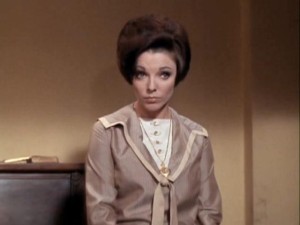
Edith runs a mission-slash-soup kitchen and clues in right away to the fact that Kirk and Spock, who greet her in stolen clothes after breaking into the basement of her mission, are hilariously out of place. But she still offers them a meal, a job, and a place to sleep, because Edith Keeler, despite her somewhat confused motivations and sadly absent backstory, is a Good Person who just wants to help people. She’s also a futurist, predicting the advent of atomic power and space travel. She’s a woman out of time, just like our stranded away team. And because the universe, no matter the timeline, wants James Kirk to be forever alone, he falls head over heels for Edith Keeler.
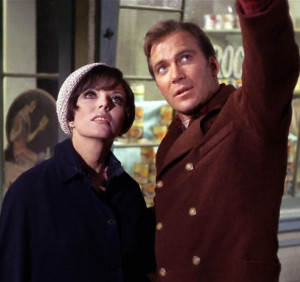
Yeah, you can guess where this is going.
Naturally, it turns out that Edith Keeler is the crucial focal point to which they’ve been drawn: in the new timeline, created by Bones’ interference, Edith sparks a peace movement that, uh, lets the Nazis win World War 2. In the original timeline, Edith dies in a traffic accident. Because it’s hard to argue with “okay but if she lives the Nazis win,” the obvious conclusion, as Spock says to Kirk, is that “Edith Keeler must die.”
…which, incidentally, is the best band name we have ever heard in our lives.
This is often hailed as the best episode of Star Trek. We don’t necessarily agree with that, though it does leave a powerful impression that is both sad and hopeful, and difficult to explain. In fact, it necessitated an after-hours two-hosts-of-three (sorry, Kim!) addendum, because we just couldn’t stop talking about it.
…or humming the Littlest Hobo theme song, embedded below for your edification if you’re not Canadian and have no idea what we’re talking about.
Podcast: Play in new window | Download | Embed
Subscribe: Apple Podcasts | Email | RSS
Ari
March 23, 2016
Episode 27 – TOS 1×27: “The Alternative Factor”
So this is one of those times where “hot mess” doesn’t quite do the episode justice.
The Enterprise is minding her own business, doing a boring, run-of-the-mill planetary survey, when all of a sudden, existence blinks. Literally, the entire universe seems to shiver and shudder and very briefly stop existing. How they, or Starfleet, which immediately dials them up to go “WTF!”, detect this precisely is a mystery best left to the annals of TV history. Maybe a Reality Integrity Detector is standard equipment for the farfaring starship?
Down on the aforementioned boring planet, there is suddenly a lifesign where once there was none. The crew investigates, and discovers Lazarus, who claims his enemy, who pursued him here and then attacked him, is out to destroy reality, and he needs the Enterprise’s help to stop him.

In Trek’s first foray into alternate universes, nobody can seem to decide how anything works. It’s like four different plots all crammed into one episode, at least half of them contradicting the other half. What people know and when and why they care about it is equally unclear; Lazarus, who turns out to have an alternate-universe doppelganger, switches identities so often that I stopped caring about keeping track. More than a quarter of the episode is taken up by our dimension-hopping guest star having body-switching fits up against bulkheads while the picture flares to negative-zone in the strangest TOS effects choice we’ve seen so far. And that’s all without even addressing the utterly baffling and consistently inconsistent take on how alternate universes work.

One bright spot (the biggest bright spot, who are we kidding) is the debut – and sadly, only appearance – of Lieutenant Charlene Masters (played by Janet MacLachlan, who had a guest role in basically every TV show made between 1965 and 1985), engineer, who steals every scene she’s in by being amazing and competent and simply does not have time for this alternate-universe-doppelganger nonsense.
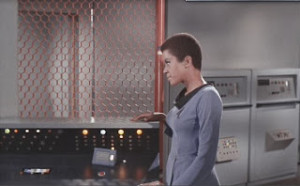
So this episode, kindly put, is crazypants. That’s not to say that as an artifact of sci-fi history, and Trek history, this isn’t interesting. There are a lot of threads that lead to later, more established Trek treatment of the whole alternate universe doubles trope, though I think it’s safe to say that later Trek, even later TOS, did a better job of keeping the many mechanisms of time-and-alternate-universe travel internally consistent. There’s a whole under-running theme here about positive v.s. negative universes that would be better ignored altogether. But this episode is high-stakes – the possible destruction of eternity, if Lazarus doesn’t succeed in stopping his double – and is resolved in one of our favourite ways: with Kirk and a guest star having a talk about science and thinking out the problem.
And then some hilarious wrestling. But what would an episode of classic Trek be without that?
Podcast: Play in new window | Download | Embed
Subscribe: Apple Podcasts | Email | RSS
Ari
March 16, 2016
Episode 26 – TOS 1×26: “Errand of Mercy”
So the chatter around this episode before we watched was basically KLINGONS KLINGONS KLINGONS. Because this week’s story involves the first appearance of our favourite (I know, we say that every time) Star Trek aliens: The Klingons!
…well, sort of. There’s a running joke regarding Original Klingons versus Classic Flavour Klingons, i.e. pre-Bumpy-Forehead v.s. Post-Bumpy-Forehead. Until the Enterprise storyline that tried (not super-gracefully) to explain away the drastically differing appearances of early and classic Klingons, the best explanation was basically “we do not discuss it.” Generally speaking this is the explanation we prefer, because early Klingons were… different. Warlike, sure. Super into military service, sure. Our favourite wine-swilling, wild-haired warrior poets?

…ehhhhh, not so much.
With war looming on the horizon, the Enterprise is dispatched to secure peaceful, pre-Warp Organia, a civilization that has stalled somewhere around Barely Medieval and just happens to be right in the path of the imminent Klingon invasion. Their planet is strategically valuable, and the Federation wants that planet secured for the protection of the rest of the region. Also, Klingons have a habit of enslaving and massacring their conquered subject worlds, which is something the Federation would like to avoid if at all possible.
Only one problem: the Organians don’t want the Federation’s protection. And then suddenly it’s too late: the Klingons have arrived, and the away team (only Kirk and Spock) are left stranded in the middle of an occupation.
You might describe this episode as a story about imperialism, and how even the benevolent kind of assimilation is Not Really That Great. That’s a valuable discussion to have, especially in Star Trek. Trek canon never stops talking about the fact that even though the Federation is, by and large, a benevolent force for good, the very mechanism of a society so large and powerful means that imperialism and assimilation, often explicitly denounced in Trek as negative, destructive things (that’s basically why the Prime Directive exists), are always waiting in the wings. A great example of this is the famous Root Beer Speech from DS9 (the important bit starts at at 1:35).
Two-thirds of us, though, were too caught up in the glaring, obvious fact that the supposedly helpless, primitive people the Enterprise was sent here to protect were secretly (SPOILER) all-powerful, non-corporeal ascended balls of light who were never in any danger, only took physical form to trick the actually-primitive visitors on both sides, and when the situation becomes genuinely inconvenient for them, snap their fingers and bend the Federation and Klingon forces to their will, declaring the war over. I mean, no war = good. But you might ask: “why take physical form in the first place?” They’re ascended! Beyond all mortal cares! All-powerful and all-knowing! And would they even have intervened if the Klingons and the Federation hadn’t shown up to play loud space-music on their front lawn? WHO KNOWS. (They definitely never interfere in galaxy-spanning space-war again, at least not in this reality, so I’m thinking… no.)
This incensed some of us (mainly me), and it took us a while to realize why this sort of high-handed behaviour felt so familarly infuriating. And then we remembered: the ascended jerks from Stargate.
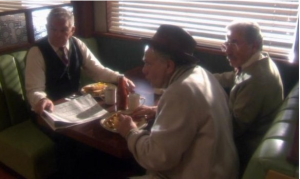
Ascended Omnipotent Aliens: dicks in every galaxy.
Podcast: Play in new window | Download | Embed
Subscribe: Apple Podcasts | Email | RSS
Ari
March 9, 2016
Episode 25 – TOS 1×25: “The Devil in the Dark”
So here are some things I have learned about mines from a lifetime of sci-fi and murder mystery consumption:
- stay out of mines; mines are trouble
- if you have to go into a mine, use the buddy system
- if you lose sight of your buddy, return to the surface immediately
- if you hear weird noises not easily explained by normal mine-type activities, return to the surface immediately
- if you have lost sight of your buddy, are hearing weird noises and a bunch of people have disappeared in or near this mine really, really recently? return to the surface immediately, at a dead run if at all possible; forswear all mines (and caves) forever
- see #1
In this episode, apparently nobody knows about the Cardinal Rules of Mines, because we open with a bunch of space miners ignoring every last one of them. Apparently some kind of monster has been killing (taking?) miners – 50 of them, as we join our not-long-for-this-world space miners – but they still definitely think it’s a good idea to leave one guy to guard the mining equipment armed with nothing but a class 1 phaser which in previous encounters has done precisely nothing against the mine-monster, the titular devil in the dark. Apparently the miners are banking on the imminent arrival of the Enterprise to save them and their mine, but sadly, help will not arrive in time to save poor, poor Sorry-Dude-But-Somebody-Has-to-Stand-Guard, who we see bite it in the first minute and a half of the cold open.
Of course, even our brave crew don’t have much luck with the monster at first – in fact, Kirk & Co don’t even seem to believe the monster exists! Which seems a little strange, given the 50 missing-probably-dead miners, but idk, maybe running off with a duffel bag full of space minerals is a real problem in 23rd century mines. Instead, what our good captain and his first officer first do is stand around, look skeptical, and fondle the mysterious, geological oddity the chief miner has displayed, totally inconspicuously, on his desk – a smooth, perfectly spherical, pure silicone ball – apparently the new level they just reached with their machines is full of them. And yes, this episode is equally full of ball jokes. Sorrynotsorry.
The above absurdity aside, this is actually a really great, classic episode of Star Trek. It’s a logic puzzle, really,where our heroes have to figure out what the monster is, what precipitated the sudden attacks after decades of incident-free mining, and why the monster – the Horta – was suddenly driven to kill. Because don’t be fooled: this is not a monster-of-the-week story. To stop the killing, Kirk, Spock and Bones have to step outside of their established body of knowledge, and solve a problem so alien and new that neither their usual problem-solving methods nor their highly advanced equipment can fully prepare them for it, or really help them. To win the day, our heroes have to totally re-think the definition of “life” as they know it. This episode gives us a situation where human beings (and half-Human beings, in the case of Spock) must grow and learn and depend upon the better angels of their natures in order to survive.
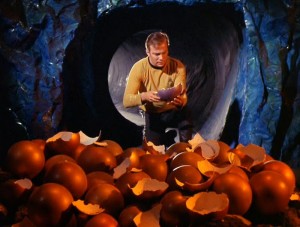
Suspend your disbelief and accept the hilarious 60s effects and the moments of extreme, committed scenery-chewing, and this story delivers a genuinely effective message: that life, and sentience, and intelligence, and people, in the purest sense, don’t always look like us, or anything you might expect, and that is not a requirement for someone to deserve your compassion, or your respect.
“If you can learn to feel for a Horta,” said Gene Roddenberry, about one of the most popular episodes of the Original Series, “you may also be learning to understand and feel for other Humans of different colors, ways, and beliefs.” And if that’s not the very essence of Star Trek, I don’t know what is.
Podcast: Play in new window | Download | Embed
Subscribe: Apple Podcasts | Email | RSS
Ari
March 2, 2016
Episode 24 – TOS 1×24: “This Side of Paradise”
In this week’s episode, the Enterprise crew is dispatched to investigate the fate of the worst summer camp of all time.
Technically they’re trying to establish the fate of the probably-lost colony of Omicron Ceti III – “lost” because after the colonists had already departed, Earth scientists discovered that the planet was under constant bombardment by deadly radiation that not only kills within a week but disintegrates unprotected organic tissue. (I mean, “lethal disintegrating radiation” would definitely be in the “must verify” Cons column in my Should We Colonize This Planet Pros/Cons checklist, but what do I know, I have an English degree.) The Enterprise arrives expecting to find no trace of the sadly-dead colonists, but then beam down to discover that… uh, they’re definitely all alive. Somehow.
Hey there, say the colonists. Sorry we haven’t called, but our space radio was busted, and we were busy founding a collectivist space farm commune on this perfect, perfect, perfect, perfect planet!
Fortunately this is one of those times where our heroes look at each other and say “hey, that’s weird,” and they keep asking reasonably pertinent questions, like a) what happened to all of your farm animals? and b) why are you all so eerily content? And actively attempting to solve the mystery.
Also present among the colonists is a woman from Spock’s past, botanist Dr. Leila Kalomi, who had a Thing for Spock that, by all evidence, he either did not, or could not, reciprocate. Leila is delighted to see Spock again, and equally delighted to answer all of his questions about how the hell they’re all still alive. The answer, amazingly, is flowers – flowers that, uh, well, there’s no other way to say it: ejaculate into people’s faces the moment they get close enough.

Leila exposes Spock deliberately, hoping to convince him to stay with them and, specifically, with her – and is upset when the affect of the isn’t as painless for half-Vulcan Spock as it was for the purely-Human colonists. He comes out the other side, though, as One of Them – because the flowers’ spores not only protect the colonists from radiation, but also create a kind of psychic groupthink that suffuses everyone with an overwhelming sense of perfect happiness and serenity, which doesn’t sound so bad until you substitute “serenity” with “total social stasis and possible mind control.”
Weirder still, under the influence of the flowers Spock is happy, for the first time in his life, which Nimoy portrays in a way that is somehow both gratifying (because even by whatever definition you want to use for a half-Vulcan, Spock is not, generally, a very “happy” man) and deeply, deeply unsettling (because flower-high Spock is disarmingly, heart-breakingly happy). Especially once he joins the colonists in their mission to convert the entire Enterprise crew.
Kirk saves the day by virtue of his immunity to happiness, but we’re left with some pretty troubling questions, like is happiness, imposed from without, really happiness? And is it better to be content but never change, or to change and grow at the expense of perfect serenity? And is paradise, by those descriptors, something anyone really wants?
Podcast: Play in new window | Download | Embed
Subscribe: Apple Podcasts | Email | RSS
Ari
February 24, 2016
Episode 23 – TOS 1×23: “A Taste of Armageddon”
This week’s episode is best described as a game of RISK that got massively out of hand.
Our fair ship is ordered (against the better judgement of literally every member of the crew, it seems) into a region of space with a galactic-standard Do Not Enter sign hung on the door. These orders are issued by Federation Ambassador Fox, AKA: The Beigest Man Alive, who probably should look into another career because he is actually not very good at diplomacy. Kirk protests that going in there is a) a bad idea and b) could totally start a war, but Fox insists, and in they go.
Guess what happens.
Not only is the Enterprise crew instantly sentenced to death the moment the away party beams down, but it gets crazier: this planet has been engaged in a 500-year-long war with a neighbouring world where casualties are caused not by bombs and guns, but calculated by computer – at which point the unfortunate victims of mathematics walk willingly into a disintegration machine. We kill 3.1 million of ourselves every year in this war, say their extremely solicitous hosts! It’s no big deal!
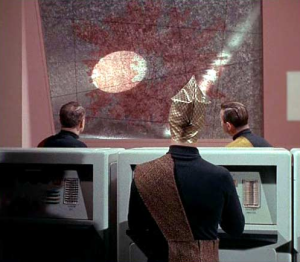
As you might imagine, Kirk & Co. object in the strongest possible terms.
This episode also features guest star Barbara Babcock, who went on to join the secondary cast of Doctor Quinn, Medicine Woman, which you’ll know because of the 2.5 minute micro-lecture at about minute 26. It also also contains the second appearance of Yeoman Tamura (played by Miko Mayama, first seen in Court Martial), who is highly competent and wishes she got to point alien space-crystal-rayguns at people more often.

The consensus is that this episode was and remains relevant to the way we, in the West, view distant wars. In 1967, this was a thinly-veiled metaphor for Vietnam conscription and the Television War – in 2016, it’s a commentary on drones and our ability to kill real fellow humans from thousands of miles away using what is basically an Xbox controller. Eerily lifelike, and sufficiently chilling that despite the usual massive plotholes and inexplicable decision-making, I think this one holds up.
Editor’s Note: There’s a point where I suggest this episode contains callbacks to the movie Logan’s Run, before Kim reminds me that Logan’s Run the movie came out in 1976, and A Taste of Armageddon hit TV screens in February 1967. Logan’s Run the book was published in 1967, but I couldn’t find a specific date. Who knows? But if the two were unrelated it’s a hell of a co-incidence. (tl;dr: watch Logan’s Run. Sci-fi classic. Scary. Very Good.)
Podcast: Play in new window | Download | Embed
Subscribe: Apple Podcasts | Email | RSS
